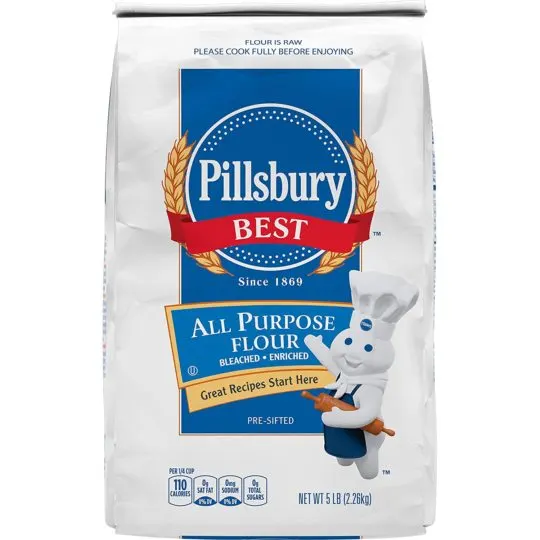Depending on how much you know about pastries and the general baking procedure, shopping through the supermarket’s baking section may be either an exhilarating or terrifying experience. There are a variety of flours available, including all-purpose, pastry, bread, and cake flours. But what’s the difference between bread flour and all-purpose flour, and how can you tell which one will serve the purpose you seek in your baked recipes?
In this article, we describe both flour types, the key differences, and existing similarities, as well as which baked recipes they are individually ideal for. In addition to these facts, it is great to get familiar with how possible to use one flour instead of the other to achieve the best results.
If there is no bread flour to use in your baked recipes, the information we have compiled in this article should help you properly substitute all-purpose flour in its place. So, sit tight and get ready to expand your knowledge of the two flour types and properly incorporate and take advantage of them in your recipes for the best-tasting finished products.

All-Purpose Flour Nutrition Facts

All-Purpose Flour Vs. Bread Flour
The protein composition of bread flour differs from other flour forms, which can be considered the main basis of its uniqueness. Flour’s protein content allows it to strengthen dough and aid in bread rising. Bread flour typically has a high protein level of 12 to 14 percent, making it ideal for recipes that require a solid dough and texture and a lot of elastic gluten formation.
Bread flour’s protein absorbs more liquid than other flour, resulting in the hard and solid dough. It is great for providing loaves, buns, pizza dough, and other baked goods with more height, strength, and elasticity.
On the other hand, all-purpose flour is useful for all baking purposes, and it typically comprises about 10 to 12 percent protein. Standard all-purpose flour is white flour, which means the bran and germ have been removed during processing and grinding, leaving only the starchy endosperm.
Unfortunately, this means that much of its nutritional benefits have been lost, as has much of its original flavor. However, the advantage of all-purpose flour is that it behaves consistently in baking. Also, as its name suggests, all-purpose flour is more versatile than bread flour.
Substituting All-Purpose Flour and Other Options for Bread Flour in Recipes
In general, all-purpose flour can be used in any other flour form. Although the texture may not be quite as good, it’ll suffice. Bread flour, in particular, can be replaced with all-purpose flour in a wide number of recipes.
Other alternatives can work in bread flour in baking procedures, apart from all-purpose flour. Some of them have been described below:
All-Purpose Flour
All-purpose flour is an excellent substitute because it has the second-highest protein and a well-balanced blend of hard and soft glutens. However, it can be considered the best possible option to use in the absence of bread flour. Because it is perhaps already in your pantry, this is a great substitute option in terms of accessibility and capacity.
The outcome will depend on the type of bread you’re trying to prepare. For example, to bear the weight of the grains in mixed-grain bread like rye and barley, bread flour’s exceptionally strong rising capacity is required.
Bread flour is heavier than all-purpose flour, so while you can use the same weight, you’ll have to measure all-purpose flour out differently. It is also important to allow the dough to rest for a while before kneading for finished products to be fluffier.
Rye Flour
Because rye is a grain that grows in milder regions than wheat, it is more commonly used in northern cultures’ cooking. For example, you may buy rye flour in various grades, ranging from whole grain dark rye, which contains all sections of the grain and makes delicious dark, chewy bread, to first clear flour, which is used to make lighter deli rye.
Because rye’s protein structure differs somewhat from wheat’s, it does not create as strong a gluten network. Therefore 100 percent rye bread is denser and chewier than wheat bread. When using rye flour as a substitute for bread flour, use 50% rye flour and 50% whole wheat flour for the best results.
This substitution approach allows for a remarkably soft and moist bread that retains these features even after a few days have passed.
Bob’s Red Mill, Organic Pastry Flour, Whole Wheat
Pastry flour, which has a low protein content of about 8%, is ideal for delicate pastries but not yeast bread. The gluten contained in bread permits it to maintain its structure as it rises, and the lower the protein content of any wheat, the less gluten it can create.
Pastry Flour Blend, which is pastry flour with a protein level (10.3%) strong enough to sustain a certain degree of the high-rising structure while remaining low enough to generate delicate pastries, can aid in this regard. If you have a bag of pastry flour blend stowed away and believe it’s only suitable for cookies and pie crust, think again: this smooth flour produces fantastic pull-apart pan bread, too.
Frequently Asked Questions (FAQs)
Can I substitute regular flour for bread flour in the bread machine?
It’s fine to use all-purpose flour in the bread machine, even if it lacks enough gluten. The worst that can happen is that your bread will not rise as much as if made using bread flour.
Can you substitute all-purpose flour for bread flour in sourdough bread?
Yes, but it isn’t necessarily fair trade. Because all-purpose flour absorbs less water than bread flour, you’ll need to lower the overall amount of water in a bread flour-specific recipe, and the dough will be excessively sticky otherwise.
What flour is best for sourdough bread?
Because the microorganisms feed on sugar, any flour containing starch is ideal for a sourdough starter. Glutinous flours work well, such as spelled einkorn, rye, and wheat.
Conclusion
If you don’t have bread flour on hand and need some to make a recipe, you may save yourself a trip to the store and a few dollars by substituting an equal amount of all-purpose flour in its place.
People are cautious about working with baking substitutes for not getting the same result. However, the resulting differences are minor. Let nothing stop you from exploring available substitutes for bread flour in your recipes. You might even love the new taste.




